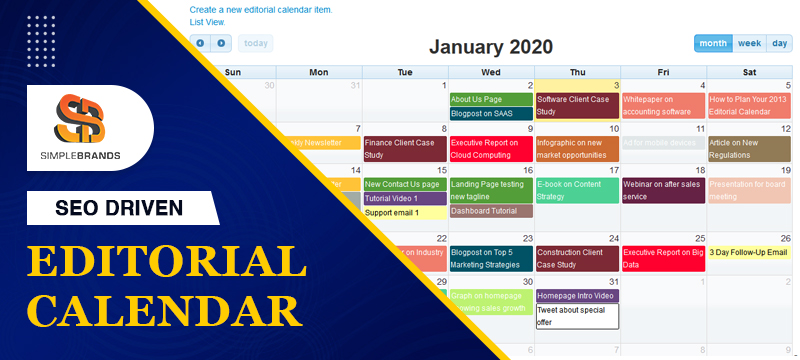An editorial calendar is an essential tool that helps in managing the entire life cycle of content marketing strategies. There are a lot of tools available in the market dedicated to offering various types of calendaring capabilities. However, depending on your requirements and with adequate efforts, you can convert a spreadsheet into an editorial calendar. In our previous post, we have shared with you the steps involved in creating an editorial calendar. You can check our blog ‘How to create SEO driven editorial calendar‘ for that. In this article, we are going to share information to include in an editorial calendar.
Information to Include in an Editorial Calendar
You can consult any digital marketing agency Charleston, SC regarding creating effective content marketing strategies for the promotion of your brand. Based on the resources available and your marketing goals, you can decide the content and the design of your editorial calendar. You can also decide on the members who can access the same. You can work with the digital marketing agencies from whom you are availing content marketing services in this regard. As a business owner, you need to share with them your upcoming marketing campaigns or product launch, etc. The same they can put on their editorial calendar. It will help them create content for your campaigns and promote them accordingly.
At the basic level, if you are a digital marketing agency offering content marketing services in Charleston, SC, you must include the following information in the editorial calendar.
Content Creation and Publishing Dates –
Create date field – one for when the content would be created and another one when it should be published. If you follow a comprehensive content marketing strategy, you may want to include dates for facts checking, proofreading, etc.
List of Content –
Based on your content marketing strategy, create a list of content that is to be published in the following month. It can include future posts, existing posts that would be remarketed, etc.
Name of Team Members –
Team members responsible for creating and publishing the content. It can include content writers, editors, graphic designers, agencies, etc.
Current Status of the Content –
This will help you to track whether your content plan has been successfully put into action or whether there is any backlog content. Tracking the actions at every stage will help you understand how far you have succeeded in your content marketing strategies.
Once you have determined your specific business goals and the workflow of your content team, you need to determine the format of the content and platforms for which you want to create and publish your content. In this regard, you need to include the following information in your editorial calendar. It will help you stay organized and monitor your content marketing strategies.
List of Channels –
Include the channels where you want to publish and share your content. It includes web blogs, emails, newsletters, preferred social media channels of your audience, etc. Apart from owned channels, you can also track other paid and earned channels.
Content Formats –
Next in your editorial calendar you need to include information such as the format of the content you want to create, publish, and distribute. You can decide whether it should be a web blog whose link you want to share on your other social media channels. Otherwise, you may want to create visually appealing images, videos, infographics, and podcasts specifically for your owned social media channels.
Visuals –
Also, you should not ignore the visual elements in your social sharing content and also your overall brand recognition. Ensure that your post contains your brand logo and other elements to ensure that your content has a signature look and your brand identity.
Topic Categories –
Include information such as the topics of the content you have created or are going to create in your editorial calendar. It will help you track the topics that have already been covered. As a result, you can determine which future content topics you need to focus on.
Keywords –
At the beginning of your content marketing strategy, you might already have done the keyword research. Now you need to include those keywords in the editorial calendar to ensure that you include them while creating your content.
Metadata –
It includes Meta titles and descriptions that will help you align your content creation with SEO efforts.
URLs –
You also should include information such as the URLs of your published content in your editorial calendar. This info will help you track all your published online content. You can use them in your new content to link back to your older content. This form of internal links will encourage your readers to spend more time on your website. It further would help in improving your rankings on search engines.
Call to Actions –
This will help you to maintain that all your content marketing efforts are aligned to the digital marketing strategy of your business.
Therefore, by including all the information mentioned above in your editorial calendar, you can put your content marketing strategies into action effortlessly and in an organized way. It will help you to have your job completely under control and not miss anything that you have planned for in terms of content marketing.
Simple Brands Media offers a wide range of digital marketing services in Charleston, SC, to their clients. If you share your business goals with us, we can help you in creating effective content marketing strategies for achieving them. For any forms of digital marketing solutions, feel free to contact us.

